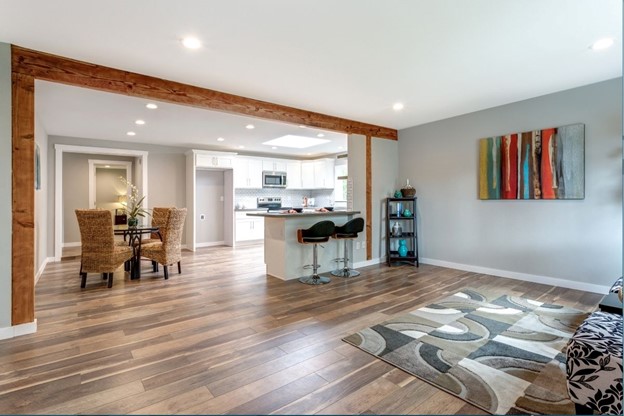
Purchasing a home is no easy task and requires a lot of investment. Even then, much must be done to ensure it looks exactly how you want it to. Additionally, every homeowner will want their house to look as beautiful and appealing as possible. This is because they want their home to reflect their investment price and emotional attachment to it. However, there is a range of factors that you need to consider to revamp your home. This includes a variety of repairs that EaseFix can take care of.
One thing in particular that people tend to worry about is their home's flooring. Flooring tends to go through a lot of wear and tear, especially if the house is small. So, what work can you get done on the floor to make your home look more appealing? This article will provide you with 5 interior flooring tips to make your home more appealing.
Let's dive in.
1. Use Wooden or Imitation wood flooring
Wooden flooring can make any home look classy because of its elegance and style. It is the closest thing to nature, ensuring it does not make your home look too monotonous. Therefore, adding a wooden floor can undoubtedly boost your home's appeal. However, maintaining wooden flooring can be an issue. This problem can be solved using high-quality wooden flooring from a trusted company or imitation wood flooring made from ceramic. Such flooring can bring the elegance of wood and functionality of ceramic.
2. Make rooms look bigger with light flooring
Larger rooms are more appealing because they give the impression of space. This makes a person inside a room feel more accessible and more tranquil. If you have small rooms or want to make your rooms look more extensive, you can use certain tricks. You can add light or white flooring options to make your room look bigger. Light colors reflect light more, making your house look more open and inviting. You can enhance this effect by having more open windows reflecting natural light in your rooms.
3. Align the interior and exterior flooring of your house
This trick will help your house look bigger and create continuity. This is due to the openness of the outside penetrating the inside. Typically, the boards or tiles installed on the patio and the house's interior from the front door are different. This is not an issue, although matching colors or materials can help the continuity. However, the most important thing is to align the boards or tiles inside the house the same as the patio. This will give the sense that the outside space is being transported inside the house, making it feel more open and airy. In this way, continuity can help your home look more appealing.
4. Install Classic Style Monochrome Tiles
Classic-style monochrome tiles are associated heavily with Victorian Era and luxurious European homes. This style has stood the test of time and is still relevant today. Therefore, adding such tiles to your home can give it a traditional classiness that the latest trends cannot do. These tiles are also available in a range of patterns and painted colors. This means you can choose from various options to ensure that your flooring is compatible with the theme of the rest of the house. For example, black-and-white monochrome tiles work well with black-and-white furniture.
5. Add Carpeting for Softness and Coziness
Another aspect that adds appeal to your home is how cozy and comfortable it makes you feel. Some people may dislike tiles because they are hard and slippery. Therefore, you can opt for soft carpeting as a flooring option that ensures that your every step is soft. Not only does it feel nice, but it also looks nice as it is available in various patterns and designs. These designs are also not restricted to being within a square like tiles tend to be, so you can have a more consistent design on your floor. The carpeting will also prevent loud squeaky noises and cover damage to the floor.
Conclusion
Everyone wants their home to look appealing due to the extensive investment required and the emotional attachment they may have to it. There are various ways to make your home look more attractive, which includes flooring. You can consider adding wood or imitation wood flooring, as it looks exquisite and natural. Light flooring can help your room look bigger and more appealing, as it helps reflect natural light. There is a trick you can use by having the boards of your interior and exterior line up, which creates continuity and makes the house look more prominent. Consider adding classic monochrome tiles, as these have stood the test of time and will give your home a traditional classiness. If tiles aren't your thing, consider adding carpeting, as it will make your floor softer and cozier while providing other benefits that will boost your home's appeal.
We hope this article proves insightful and gives you ideas that help improve your home's appeal. Thank you for reading, and good luck!







